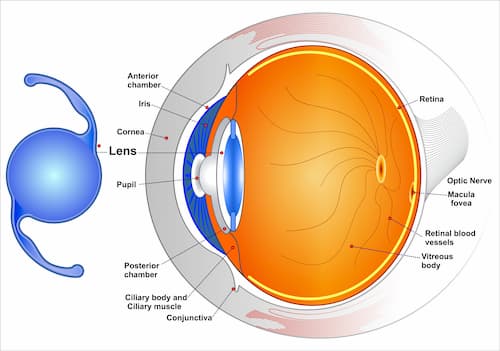Cataracts

What is a Cataract?
A cataract is the clouding of the normally clear lens of the eye, which prevents light entering the eye from being focused properly on the retina. Cataracts are a normal part of the aging process and can begin to affect the clarity of vision as early as age 50. In fact, it is said that most people will develop cataracts if they live long enough.
Early changes may not disturb vision, but over time, cataracts will result in
- blurred or fuzzy vision
- difficulty reading
- difficulty driving at night
- Sensitivity to light & glare.
People with advanced cataracts often say they feel as if they’re looking through a waterfall, or a piece of wax paper.
Cataract Symptom Checker






Currently, there is no medical treatment to reverse or prevent the development of cataracts. Once they form, the only way to achieve clear vision again is through cataract surgery. In your parents’ or grandparents’ day, cataract surgery was considered quite risky, required a lengthy hospital stay and was usually postponed for as long as possible. Today, cataract surgery is a comfortable outpatient procedure that allows patients to avoid the inconvenience and expense of a hospital stay. In fact, most patients’ vision recovers well enough to see to drive as quickly as one day after surgery.
Take our cataract self-test to see if you’re a good candidate for cataract surgery
Cataract surgery is considered to be one of the safest and most successful procedures performed in medicine today. It involves creating a microscopic pin hole size incision through which the cataract is removed and a foldable intraocular lens (IOL) is implanted to replace the clouded lens. This small incision seals itself naturally and allows for comfortable and rapid healing.
Learning that you have a cataract can be a cause for concern. But once you understand how your vision can be restored and even improved with advanced Laser Cataract Surgery at Larson Eye Care, you may have reason to celebrate!
The clear benefits of Laser Cataract Surgery
Larson Eye Care is the only provider in the area now offering the advanced laser cataract technology of the LENSAR™ Laser Cataract System. Specifically designed for cataract surgery, it uses a bladeless, high-resolution 3-D CSI imaging device that gives our surgeons a fully automated analysis of the cornea and lens surfaces for incredibly precise surgical incisions. This more individualized surgical accuracy takes only 15-20 minutes, and also gives patients a safer, more efficient and more precise cataract removal. The LENSAR laser means better lens positioning, less trauma to the eye, a quicker recovery and more predictable visual results — all factors that are important for individuals wanting to reduce or eliminate their dependence on glasses.
Cataract removal … and more
Laser Cataract Surgery removes the cataract, performs additional procedures at the time of the surgery, and replaces the cataract with an IOL (intraocular lens) that reduces one’s dependence on glasses or bifocals. Specifically, it enhances clear vision by reducing astigmatism, a condition that still remains after a standard cataract surgery. For most cataract patients, life without glasses or bifocals is something they only experienced when they were quite young — or just dreamed about for much of their lives.
Discover the clear benefits that Laser Cataract Surgery has to offer. Call to set up your consultation today!
Cataract lens replacement:
How Intra Ocular Lens Implants (IOL) work
Like your eye’s natural lens, an IOL focuses light that comes into your eye through the cornea and pupil onto the retina, the sensitive tissue at the back of the eye that relays images through the optic nerve to the brain. Most IOLs are made of a flexible, foldable material and are about one-third of the size of a dime. Like the lenses of prescription eyeglasses, your IOL will contain the appropriate prescription to give you the best vision possible. Read below to learn about how IOL types correct specific vision problems.

Which lens option is right for you?
- Before surgery your eyes are measured to determine your IOL prescription, and you and your Eye M.D. will compare options to decide which IOL type is best for you, depending in part on how you feel about wearing glasses for reading and near vision.
- The type of IOL implanted will affect how you see when not wearing eyeglasses. Glasses may still be needed by some people for some activities.
- If you have astigmatism, your Dr Larson. will discuss toric IOLs or Incisional Refractive surgery (Limbal Relaxing Incisions )and related treatment options with you as methods of improving post-operative vision.
- We offer Advanced Technology Lenses (ATL) to aid in better night vision.
- In certain cases, cost may be a deciding factor for you if you have the option of selecting special premium lOLs that may reduce your need for glasses.
In addition to Dropless™ cataract surgery, Larson Eye Care now offers Laser Cataract Surgery. As the only provider in the area using this bladeless LENSAR™ Laser System technology, we can provide a more precise cataract removal customized to the individual eye. It’s just one of many clear benefits of advanced Laser Cataract Surgery!
Deciding to have Cataract Surgery

A comprehensive dilated eye exam is the first step in deciding to have cataract surgery. During your exam, your symptoms will be reviewed and your vision will be checked to determine whether a change in your correction will improve your symptoms.
Dr. Christopher Larson and Dr. Todd Larson will review the results of your exam and based on the information may advise cataract surgery. If surgery is recommended, your doctor will review with you the risks and benefits of surgery. Except for isolated cases, cataract surgery is an elective procedure, the decision to proceed is entirely yours.
Take our cataract self-test to see if you’re a good candidate for cataract surgery
Before Cataract Surgery
After deciding to procedure with Cataract surgery, additional testing will be required to determine the health of your eye and the power of the lens to implanted. This appointment usually takes one hour in our office at which time the consent for surgery and necessary ocular medications will be reviewed with you. You will also be required to complete a history and physical with your family doctor to be certain you are in good health prior to surgery. This can be performed no more than 30 days prior to surgery and at least 3 days prior to surgery.
The Day of Cataract Surgery
Cataract surgery is performed on an out-patient basis. You will be asked to arrive at the surgery center approximately one hour prior to your procedure. A nurse will review with you what to expect during the procedure. Once in the surgery room, you will lie down on a comfortable bed and be given eye drops to numb the eye. An anesthesiologist will be present to monitor you and give light sedation during the procedure.
A microscope will be positioned over your eye and you will be asked to look up into the light. During the procedure, your doctor will stabilize your eye with a device to keep your eyelids open. You may feel slight pressure on your eye during the procedure.
After your procedure, you will be taken to the post-operative area where you will be given a light snack prior to leaving. You will need someone to drive you home. Due to medication given during the procedure, you will be asked not to drive the day after surgery. Other than this, you will have no other restrictions.
After Cataract Surgery
Most patients are able to see well within hours of having surgery. You may find that you will see better without your glasses. If a prescription lens change is necessary, your best vision will not return until you receive a new lens prescription. You will need to be examined at the office the day after your surgery. Normal activity can be resumed immediately after surgery. You will need to wear a plastic shield at bedtime for one week following your procedure and continue ocular medications as prescribed.
You may experience some tearing, light sensitivity and/or irritation following your surgery. This is normal and should improve within a day or so following your surgery.



